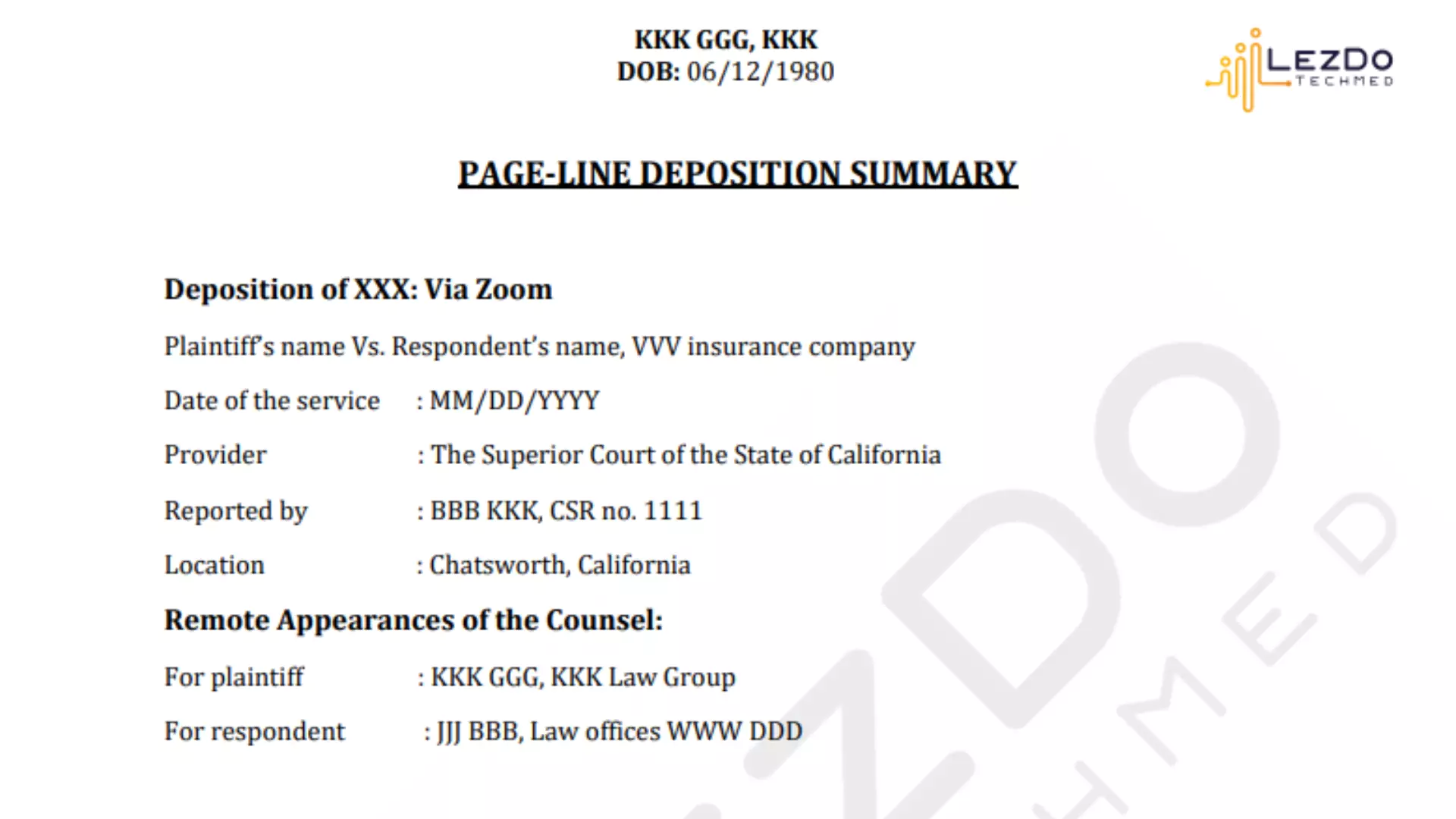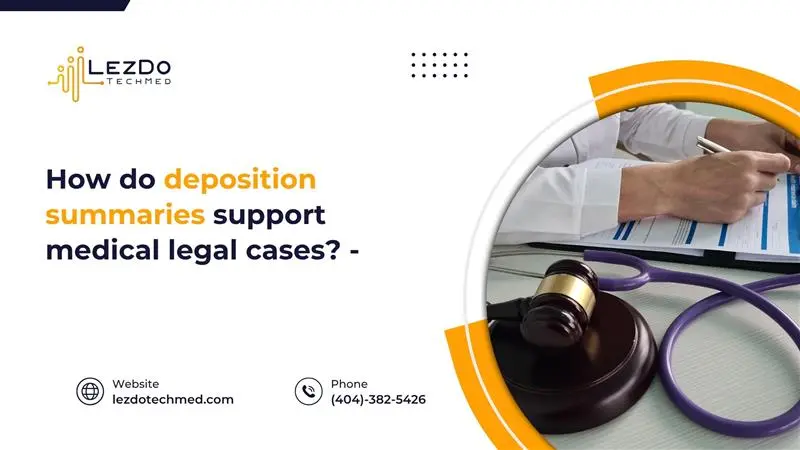Tired of scrolling through lengthy deposition transcripts? You don’t have to be. A crisp, focused deposition summary can help you spot the key points, contradictions, and insights in less time.
In this guide, let’s explore the significance of a deposition summary and the step-by-step process of drafting a precise one. Let’s dive in.
What is a Deposition and why does it matter?
Before moving on to the essence, let’s see what a deposition is and its value in litigation.
A deposition is a part of the litigation, which is often in a recorded format of the statements of the witness about what he/she knows of the particular case. What does a deposition look like? It is in the form of questions and answers recorded when the witness is under oath.
Usually, it is taken outside the courtroom for discoveries related to litigation. Attorneys will interrogate the witness to understand the facts behind the case as well as the stand taken by the witness in it.
Usually, a deposition testimony consists of hundreds of pages in the form of detailed conversations. Valid information will be hidden and scattered among the bulky deposition transcripts.
As it plays an integral part in the pre-trial and trial process in the court, the lawyers have to refer to it and decide the next step to be taken to win their litigation. When litigation needs many witnesses to be deposed, the process becomes more complicated.
What is a Deposition Summary?
A deposition summary is the condensed and laconic version of the voluminous deposition transcript. It plays an important role throughout the litigation process. Attorneys cannot go through the thousands of pages to detect the valuable points that help them succeed in their lawsuits. Paralegals, lawyers, or expert summarizers will summarize depositions and present them in a compact form.
Why do you need a Deposition Summary?
Here are the vital reasons legal professionals depend on deposition summaries:
Vital throughout the process
These summaries serve as road maps for attorneys, helping them navigate the facts during pre-trial discovery, motion practice, mediation, and trial preparation. Rather than flipping through page after page of raw transcripts, attorneys can turn to a focused summary that highlights what matters most.
Time-saving tool
When dealing with multiple depositions, manually reading and highlighting transcripts eats up valuable hours. A summary allows attorneys to absorb key points in minutes.
Helpful for non-attending parties
Insurance adjusters, co-counsel, and even clients who missed the deposition can rely on the summary to understand what was said, without needing to read the full transcript.
Enhances pre-trial and trial preparation
Deposition summaries help in drafting interrogatories, preparing motions, and planning additional witness examinations. They also refresh a witness’s memory before taking the stand.
Aids in strategy-building and impeachment
Attorneys can use deposition summaries to identify inconsistencies in testimony or to highlight statements that support their legal argument, aiding in witness impeachment if needed.
How to prepare the best Deposition Summary? Step-by-step process
Creating the deposition summary is not just about abridging the content. It is actually condensing critical facts without altering their meaning. Here’s how professionals do it:
- Read the transcript thoroughly
Read the entire transcript to understand the context and purpose of the deposition process. Perceiving what the attorney aims at and how the witness responds or refuses to answer, stutters or gives contradictory statements, etc., will help to discern the nature of the case and the validity of the allegations. Focusing on the allegations will facilitate the summarizer’s understanding of the supporting statements.
- Highlight key testimony
Identify the relevant points to be included and annotate them for easy understanding while drafting the summary. These could be admissions, clarifications, contradictions, or critical facts related to liability, causation, or damages. This will help the summarizer elucidate the justifiable statements supporting the lawsuit.
- Organize and format the summary
From the highlighted key points, the summarizer should plan how to draft a summary of the deposition. Planning the integral parts, the style of presentation, and the type of summary will make the document easily graspable to the readers.
The deposition summary process requires in-depth knowledge to collate, combine, and draft the synopsis with precision, and not to rewrite it in its entirety. Digesting a deposition is a lengthy process that needs utmost care and scrutiny, as it plays a vital role in winning litigation.
What decides the summary turnaround time?
Generally, in an hour, more than 25 pages of the transcript can be summarized. However, depending on various factors, the time to compress the deposition varies from a few hours to a few days. They are:
Type of Witness: Layperson testimony is simpler to summarize. Expert witness transcripts involving doctors, engineers, or accident reconstruction specialists are technical and may need more time to summarize.
Transcript Length: Longer transcripts (150–300 pages) naturally take more time to distill than shorter ones.
Complexity of the Case: Multi-party cases or those involving extensive treatment history, multiple injuries, conflicting facts, or unreliable witnesses require extra scrutiny.
Different Types of Deposition Summaries
To draft a crisp and effective deposition summary, you should know the various types of summaries. Here, let’s see the different formats in which these summaries can be produced.
1. Page-line summary:
Page-line summaries are prepared by filtering vital information from page to page. When compared to the other methods, this is a time-consuming one. A carefully drafted page line summary collects important statements of the witness by referring to the beginning and end of the page and line. This method is more convenient in commercial and financial transaction cases.
A minimum of 5 pages will be compressed into a single page. Go through the page-line deposition summary sample to get a better understanding of the page-line summary.

Download Sample
2. Page summary
Similar to the page-line method but references page ranges (e.g., pages 10–15). The crisp depo summary is included in one, and the starting and ending page numbers are mentioned in the other. It provides a good overview without diving too deeply into every line.

Download Sample
3. Topic-by-topic summary:
As per the title, testimony is organized under predefined topics such as employment history, accident details, medical treatment, or prior conditions. This type of summary will be helpful in fact-oriented cases, like workers’ compensation. This will have three columns, such as, topic, pages, and summary. For example, the topics may include the witness’s address, education, current job, previous job, prior accidents, subject of the accident, subsequent accidents, injuries, etc. The given sample deposition summary will guide you to draft one.

Download Sample
4. Chronological summary
The transcript summary is abridged and arranged in chronological order. The chronological sequence of facts is vital, especially in personal injury and criminal lawsuits. Lawyers prefer to have all the testimonies taken, incorporated, and organized in a sequential order. The chronological deposition summary sample attached below is an example of a chronological deposition summary.

Download Sample
5. Narrative summary
Written in paragraph form, this type of summary format follows the flow of the deposition and reads like a story. Preferred by insurers and attorneys preparing for trial. Sometimes, more than ten pages can be condensed into a single page.
From the different types of sample deposition transcript summaries available, attorneys can determine the summary format that suits their lawsuits. The deposition summary format given below will help you get vital insights.

Download Sample
What makes a good Deposition Summary?
A good deposition summary has the following traits:
- Relevant- Focuses only on important facts that are pertinent to the case.
- Clear- Uses simple, neutral language without any complex legal or medical jargon.
- Well-structured- Organized by topic or timeline for easy understanding.
- Accurate- Free of errors in vital facts, such as names, dates, or details.
- Objective- Presents facts without any bias or interpretation.
- Useful – Helps legal teams prepare quickly and effectively.
The summarizer’s job is to filter the clutter without compromising the legal significance of the statements.
Why do you need Deposition Summary Services?
Even if you know how to summarize depositions, the intricacies involved in summarizing depositions would undoubtedly make you consider the necessity for deposition summary companies. The following factors stress the need for outsourcing to deposition summary services for law firms.
Time-efficiency:
Lawyers will be time-constrained due to their tight schedule in handling multiple cases together. Summarizing a deposition is a time-consuming process, and in-house summarizing may also hinder other core litigation processes. If the work is outsourced to professional firms, experts proficient in legal and medical fields summarize the transcripts quickly. Some even provide expedited services.
Cost-efficiency:
Most paralegal staff or lawyers in law firms are paid per hour for summarizing. It is important but expensive work and would cost a lot for the clients. If outsourced, effective depo summaries will be ready at a very low cost. Pocket-friendly transcript services will be a boon to clients who are already under a financial burden.
Workflow efficiency:
Most reputable summary services have well-trained paralegals or experts to digest the valuable points from complex transcripts. They are more experienced in legal matters and understand the nature of the case, and raise valid points that could help the litigation process. Professionally created deposition summaries are more reliable when filtering the favorable factors for clients.
A deposition summary is provided by many medical record review services, which relieves lawyers of their burden and helps them concentrate on the litigation process.
FAQs
1. What is a deposition summary?
A deposition summary is a brief, structured version of a witness’s testimony taken under oath. It highlights only the most relevant facts, opinions, and statements from the transcript.
2. Why is a deposition summary important?
A crisp deposition summary saves attorneys’ time by condensing long transcripts. A clear deposition summary helps in trial preparation, case evaluation, and witness cross-examination.
3. What decides the summary turnaround time?
Generally, more than 25 pages of the transcript can be summarized by human reviewers in an hour. However, depending on the witness’s specialty, the transcript length, and the complexity of the case, the summary process can take a few hours to a few days.
4. How long should a deposition summary be?
Generally, a single-page summary can condense valuable facts into ten pages of the transcript.
5. What are the key elements of a good deposition summary?
The key elements can be accuracy, clarity, and relevance. By including only the facts that support the case and avoiding unnecessary repetition, you can achieve that.
6. Who usually prepares deposition summaries?
Legal assistants, paralegals, or specialized medical-legal service providers with experience in analyzing testimony usually prepare a deposition summary.
7. How can I make my deposition summary more effective?
By focusing on case-relevant facts, maintaining a neutral tone, and formatting it for easy reference, you can ensure the effectiveness of the summary.
8. Can AI tools help in preparing deposition summaries?
Yes. AI tools can speed up transcript review and extract key points. However, expert review ensures context and accuracy.
9. What mistakes should I avoid when drafting a deposition summary?
Avoid copying verbatim text, missing key points, or adding personal opinions. Present only what’s factual and useful for the case.
10. How does a good deposition summary help in trial preparation?
It provides attorneys with a quick reference to witness statements and contradictions, saving them valuable hours during case analysis.
To put in a nutshell,
Writing a good deposition summary doesn’t have to be complicated. With a clear process and attention to detail, you can turn long transcripts into easy-to-use summaries that actually help.
Whether you’re supporting a legal team or organizing case details, a precise summary saves time, reduces stress, and keeps things on track. Start simple, stay focused, and let the facts speak for themselves.
Need a Precise Deposition Summary?












